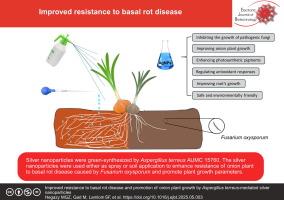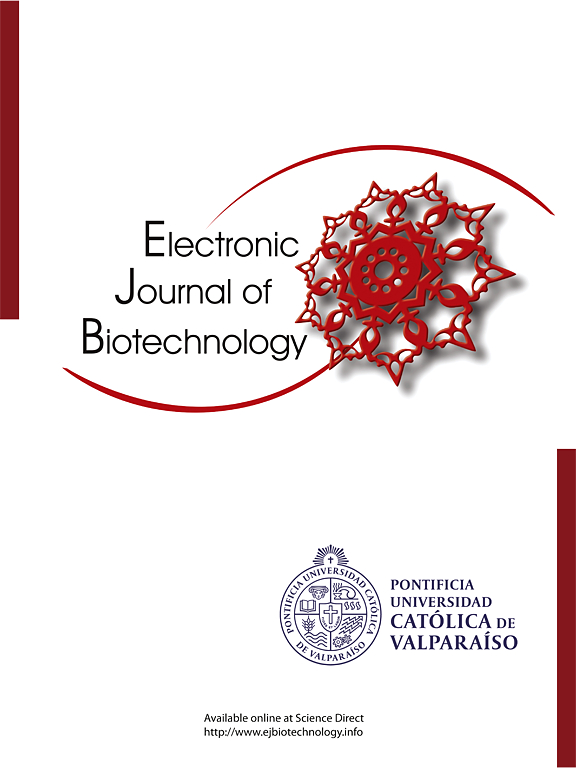土曲霉介导的纳米银提高洋葱对腐病的抗性,促进洋葱植株生长
IF 2.5
4区 生物学
Q3 BIOTECHNOLOGY & APPLIED MICROBIOLOGY
引用次数: 0
摘要
作为一种富含碳水化合物和必需矿物质的重要农作物,洋葱面临着基腐病病原菌尖孢镰刀菌的严重威胁。本研究评估了由土曲霉AUMC 15760产生的细胞外绿色合成银纳米颗粒(AgNPs)在控制由尖孢镰刀菌AUMC 15798引起的基底腐病中的有效性。结果在50、100、150和200 ppm浓度的PDA培养基中,agnps在12.1 ~ 28.7 nm范围内对真菌生长的抑制率分别为24.88%、40.77%、54.44%和69.33%。采用随机完全区组设计(RCBD)对洋葱幼苗进行温室试验,比较8种不同处理:100 ppm AgNPs(喷雾)、50 ppm AgNPs(喷雾)、100 ppm AgNPs(土壤施用)、50 ppm AgNPs(土壤施用)、Dovex喷雾(50%)、Dovex土壤施用(50%)、阴性对照和阳性对照。温室结果显示,Dovex将疾病严重程度降低了20%,显著降低了疾病严重程度。AgNPs在50 ppm时将严重程度降低到57.77%(土壤)和35.55%(喷雾),而100 ppm进一步降低到31.1%(土壤)和22.2%(喷雾)。施用100 ppm AgNPs改善了植株的生长参数。它还能提高叶绿素a、叶绿素b和类胡萝卜素的水平。在100 ppm AgNPs(喷雾)处理的植株中,酚类物质(0.34 mg/g)和花青素含量(0.48 mg/g)以及过氧化物酶(0.44µmol/min)和过氧化氢酶活性(0.19µmol/min)降低幅度最大。结论sagnps能有效防治基底腐病,促进植株生长,调节植株抗氧化活性。引用方式:Hegazy MG, Gad M, Lamlom SF等。土曲霉介导的纳米银提高洋葱对腐病的抗性,促进洋葱植株生长。中国生物医学工程学报(英文版);2009;77。https://doi.org/10.1016/j.ejbt.2025.05.003。本文章由计算机程序翻译,如有差异,请以英文原文为准。

Improved resistance to basal rot disease and promotion of onion plant growth by Aspergillus terreus-mediated silver nanoparticles
Background
Onions, a vital agricultural crop rich in carbohydrates and essential minerals, face severe threats from Fusarium oxysporum, the causative agent of basal rot disease. This study assessed the effectiveness of extracellular, green-synthesized silver nanoparticles (AgNPs), produced by Aspergillus terreus AUMC 15760, in managing basal rot disease caused by F. oxysporum AUMC 15798.
Results
AgNPs ranging from 12.1 to 28.7 nm were incorporated into PDA media at concentrations of 50, 100, 150, and 200 ppm, achieving fungal growth inhibition rates of 24.88%, 40.77%, 54.44%, and 69.33%, respectively. A greenhouse experiment was carried out using onion seedlings, with a randomized complete block design (RCBD) to compare eight different treatments: 100 ppm AgNPs (spray), 50 ppm AgNPs (spray), 100 ppm AgNPs (soil application), 50 ppm AgNPs (soil application), Dovex spray (50%), Dovex soil application (50%), a negative control, and a positive control. Greenhouse results showed a significant reduction in disease severity, with Dovex lowering it to 20%. AgNPs at 50 ppm reduced severity to 57.77% (soil) and 35.55% (spray), while 100 ppm further decreased it to 31.1% (soil) and 22.2% (spray). The application of 100 ppm AgNPs improved plant growth parameters. It also enhanced chlorophyll a, chlorophyll b, and carotenoid levels. The greatest reductions in phenolic (0.34 mg/g) and anthocyanin contents (0.48 mg/g), as well as peroxidase (0.44 µmol/min) and catalase activities (0.19 µmol/min), were recorded in plants treated with 100 ppm AgNPs (spray).
Conclusions
AgNPs effectively control basal rot disease, boost plant growth, and regulate antioxidant activity.
How to cite: Hegazy MG, Gad M, Lamlom SF, et al. Improved resistance to basal rot disease and promotion of onion plant growth by Aspergillus terreus-mediated silver nanoparticles. Electron J Biotechnol 2025;77. https://doi.org/10.1016/j.ejbt.2025.05.003.
求助全文
通过发布文献求助,成功后即可免费获取论文全文。
去求助
来源期刊

Electronic Journal of Biotechnology
工程技术-生物工程与应用微生物
CiteScore
5.60
自引率
0.00%
发文量
50
审稿时长
2 months
期刊介绍:
Electronic Journal of Biotechnology is an international scientific electronic journal, which publishes papers from all areas related to Biotechnology. It covers from molecular biology and the chemistry of biological processes to aquatic and earth environmental aspects, computational applications, policy and ethical issues directly related to Biotechnology.
The journal provides an effective way to publish research and review articles and short communications, video material, animation sequences and 3D are also accepted to support and enhance articles. The articles will be examined by a scientific committee and anonymous evaluators and published every two months in HTML and PDF formats (January 15th , March 15th, May 15th, July 15th, September 15th, November 15th).
The following areas are covered in the Journal:
• Animal Biotechnology
• Biofilms
• Bioinformatics
• Biomedicine
• Biopolicies of International Cooperation
• Biosafety
• Biotechnology Industry
• Biotechnology of Human Disorders
• Chemical Engineering
• Environmental Biotechnology
• Food Biotechnology
• Marine Biotechnology
• Microbial Biotechnology
• Molecular Biology and Genetics
•Nanobiotechnology
• Omics
• Plant Biotechnology
• Process Biotechnology
• Process Chemistry and Technology
• Tissue Engineering
 求助内容:
求助内容: 应助结果提醒方式:
应助结果提醒方式:


